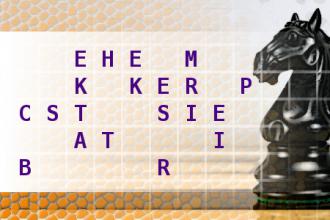Chess Knight Move
Find the title of movie, using the move of a chess knight. First letter is T. Length of words in solution: 3,6,7,4.Correct answers: 21
The first user who solved this task is Nílton Corrêa de Sousa.
#brainteasers #wordpuzzles #chessknightmove

Blessing a Body…?
A newly ordained deacon was asked to hold a graveside service for someone with no family or friends. It was his first official assignment, so he eagerly agreed.Taking his duties very seriously, the deacon let early the next morning for the cemetery. However, he made several wrong turns and quickly got himself lost. When he finally arrived more than an hour late, the hearse was nowhere to be seen and the two workmen were eating lunch.The deacon got out of his car, quickly threw on his vestments, and hurried to the open grave. Looking into the pit, he saw that the vault lid was already in place. With a sign, he took out his prayer book and read the burial service. After he had left, one of the workmen said to the other, “Maybe we should have told him he just blessed a septic tank.”

